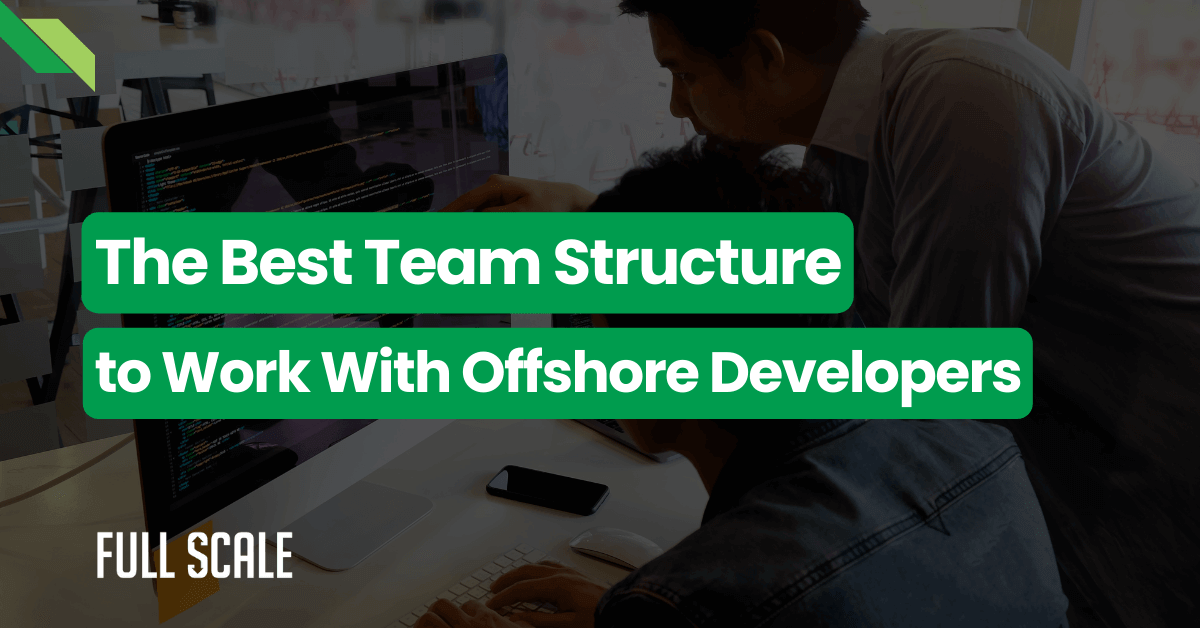Last Updated on 2025-11-16
What You'll Learn in This Guide
- Why even expert offshore advice sabotages your success
- The 3 offshore models and why only one actually works
- How to achieve 95% developer retention instead of 40%
- Real cost comparison beyond just hourly rates
- The structural changes that eliminate common failures
I’m going to lose friends with this article.
The offshore development myths you’ve heard aren’t just from failed projects. Even the “safe” advice from respected consultants will sabotage your team. I know because I followed every best practice and still got burned in 2015.
Then I figured out what actually works. And it contradicts almost everything you’ve been told about offshore development myths.
Why Both Horror Stories and Success Claims Miss the Point
Everyone has an opinion about offshore development. The pessimists share disaster stories about communication breakdowns. The optimists promise 70% cost savings and unlimited talent access.
They’re both selling you fiction.
The real offshore development reality has nothing to do with geography. It’s about the model you choose. According to a Statista study, 27% of offshore engagements fail due to structural issues, not developer competence.
Understanding why offshore development fails starts with recognizing that most advice is based on outdated project-based outsourcing models. The industry has evolved, but the conventional wisdom hasn’t caught up. These persistent offshore development myths keep companies trapped in failing approaches.
Common Offshore Development Myths Everyone Believes
Let’s address the obvious misconceptions first. These outsourcing misconceptions are easy to spot but still dominate conversations. Debunking these offshore development myths reveals why so many teams struggle.
Myth 1: Offshore Developers Are of Lower Quality
This myth persists despite the data. Stack Overflow’s 2024 Developer Survey shows that 87% of professional developers work outside the United States.
The reality behind this offshore development myth:
- The global talent pool isn’t inferior—it’s where most software innovation happens
- Your local market gives you access to maybe 5% of the world’s developers
- Limiting yourself to one geography means competing for an artificially scarce resource
- Top universities producing computer science graduates exist worldwide
Myth 2: Communication Barriers Make Collaboration Impossible
Poor communication in offshore projects isn’t about English proficiency. It’s about structure. When you hire through agencies with project managers as middlemen, you create a telephone game.
Direct communication solves this instantly. Our clients use Slack channels where developers respond faster than some onshore teams. Time zones become features when you structure work correctly.
Myth 3: Intellectual Property Theft Is Inevitable
This fear keeps CTOs awake unnecessarily. US-based contracts with proper IP clauses eliminate this risk. Full Scale’s legal structure provides the same protection as hiring domestically.
In 500+ placements over nine years, we’ve had zero IP disputes. The real risk is choosing vendors without proper legal frameworks. This is one of the most damaging offshore development myths because it stops companies from even exploring options.
The Visual Reality: How Models Compare
The differences between offshore approaches are stark. This comparison shows why model selection matters more than developer location. Understanding these distinctions helps you avoid common offshore development myths about what drives success.

This data comes from analyzing enterprise offshore engagements. The model you choose predetermines your outcome before you even hire developers. Notice how staff augmentation vs. outsourcing produces dramatically different results. These aren’t minor variations—they’re fundamental differences that directly contradict common offshore development myths about offshore work being inherently risky.
The Dangerous Truth: Even Expert Advice Sets You Up to Fail
Here’s where I lose the other half of my audience. The “safe” offshore development best practices from industry consultants are actively harmful. These recommendations sound reasonable, but they’re based on 2010 assumptions that no longer apply.
Many offshore development myths originate from these outdated best practices. Let’s examine why following this conventional wisdom almost guarantees failure.
Bad Advice #1: Start With a Small Pilot Project
Every consultant tells you to start small. This sounds prudent. It’s actually a recipe for disappointment. This advice perpetuates offshore development myths about risk mitigation.
Why this “safe” approach fails:
- Small projects signal low priority to vendors
- You get assigned junior developers between major projects
- The agency’s A-team goes to serious commitments
- You test with B-tier talent and conclude that offshore doesn’t work
- No real integration happens with throwaway projects
Full Scale requires minimum two-developer commitments. This ensures you get senior talent who can make meaningful contributions. Our 95% retention rate proves this approach works. We don’t play into the offshore development myths that pilot projects reveal quality.
Bad Advice #2: Focus on Cost Savings as Primary Benefit
Competing on price attracts the wrong vendors. The cheapest offshore options cut corners on developer salaries and benefits. High turnover follows inevitably. This is one of the most damaging offshore development myths—that cost alone determines value.
A 2024 Deloitte study found that companies focused on cost savings experienced 47% higher turnover. The savings evaporate when you’re replacing developers every six months.
Our rates run $2,000-$8,000 monthly per developer (see full pricing). Not the cheapest. But our 5% annual turnover versus the industry’s 40-60% means you actually spend less over time.
Bad Advice #3: Use Project Managers as a Communication Bridge
This recommendation makes me irrationally angry. Adding a middleman between you and your developers creates the communication problems you’re trying to avoid. This advice reinforces offshore development myths about necessary intermediaries.
Why project managers become bottlenecks:
- Requirements get lost in translation
- Developers never understand the “why” behind features
- You never build relationships with people who are building your product
- Every layer reduces understanding by an estimated 30%
The “use a project manager” advice? That’s code for “play telephone with an extra person in the chain.” You know what solves communication better than adding more people to the communication chain? Removing the unnecessary ones.
Offshore team management works when you manage developers directly. Our clients have their offshore teams in Slack and daily standups. No intermediaries. No telephone game with someone who doesn’t code translating your technical vision.
Bad Advice #4: Keep the Offshore Team Separate From Core Work
The idea that offshore developers should handle only “non-critical” work guarantees failure. You’re creating a two-tier system that makes offshore team members feel undervalued. This perpetuates offshore development myths about offshore capabilities.
The predictable outcome:
- Developers sense they’re getting busywork
- They leave for opportunities with meaningful challenges
- Your turnover soars, and costs multiply
- You blame offshore when the structure was the problem
Treat offshore developers identically to your local team. Our clients routinely have offshore developers leading critical initiatives. This respect drives retention and performance. When you stop believing offshore development myths about skill limitations, you unlock actual talent.
Calculate Your Real Offshore Costs
Traditional cost calculators only show salary differences. This tool reveals the full financial picture, including turnover, training, and opportunity costs. Most offshore development myths ignore these hidden expenses that dwarf hourly rate differences.
True Cost Comparison Calculator
Input your hiring parameters to see actual costs over 24 months. This calculator includes hidden expenses like turnover replacement and lost productivity that common offshore development myths conveniently ignore.
24-Month Total Cost Comparison
Local Hiring Total Cost
Offshore Staff Augmentation
Total Savings Over 24 Months
Cost Breakdown Details
| Cost Factor | Local | Offshore |
|---|---|---|
| Base Compensation | ||
| Recruitment Costs | ||
| Turnover Replacement | ||
| Lost Productivity |
The calculator shows why focusing solely on hourly rates misses the bigger picture. Turnover costs dwarf the salary differences. This is the offshore development reality that cost-focused approaches ignore.
The Missing Ingredient: What Actually Creates Success
I spent two years figuring out why some offshore engagements thrive while others collapse. The pattern became clear after analyzing our first 200 placements. Success has nothing to do with developer skill or geographic location.
It’s entirely about structural alignment. I call this the 3 Offshore Models Framework. Understanding these three approaches explains why some companies thrive with offshore teams while others fail spectacularly. Each model either reinforces or dismantles common offshore development myths.
Model 1: Project-Based Outsourcing (Why It Fails)
This is the traditional agency model. You describe a project, they assign a team, you communicate through account managers. It fails for structural reasons that validate the worst offshore development myths.
Why this structure fails:
- Agency incentive is maximizing billable hours
- Your incentive is efficient completion
- These motivations conflict fundamentally
- Developers are shared across multiple clients
- No long-term investment in your success
- Communication flows through non-technical project managers
- Requirements get lost in translation
Your “dedicated” developer? They’re working on three other projects. You’re not getting their A-game. You’re getting whatever’s left after their actual priorities.
Model 2: Freelancer Platforms (Why It’s Inconsistent)
Hiring through different freelancer platforms gives you more control than agencies. But you’re still dealing with independent contractors with divided attention. Freelancer platforms perpetuate offshore development myths by creating wildly inconsistent experiences.
The predictable problems:
- Quality varies wildly between freelancers
- No team cohesion or knowledge sharing
- Constant evaluation and replacement of talent
- Each freelancer works in isolation
- Building a collaborative culture becomes impossible
Freelancer platforms are a slot machine. Sometimes you hit a jackpot. Usually, you get someone who ghosts you mid-sprint.
Model 3: Staff Augmentation (Why It Works)
This model changes everything. You hire developers as dedicated team members. Full Scale handles payroll and HR infrastructure. You manage the work directly. This approach directly contradicts offshore development myths about control and quality.
Why this structure succeeds:
- Developers work exclusively for you
- They’re in your Slack and standups
- They understand your vision directly
- Incentives align perfectly for retention
- When developers stay long-term, we succeed
- This drives excellent working conditions
Our 95% retention rate proves the model works. This is a successful offshore development strategy in practice. The structure eliminates the problems that create offshore development myths in the first place.
Your Integration Timeline: What Actually Happens
One of the persistent offshore development myths is that offshore integration takes months. Here’s the reality with proper structure.
Staff Augmentation Integration Timeline
From strategy call to leading critical initiatives
Week 1
Strategy call
Requirements gathering
Tech stack review
Week 2
Developer introductions
First commits
Tool setup
Month 1
Full Slack integration
Daily standups
Full productivity
Month 3
Team scaling
Feature ownership
Code reviews
Month 6
Leading critical initiatives
Zero turnover
Full team integration
Average Time to First Contribution
8 days
vs. 45+ days with traditional outsourcing
This timeline dismantles offshore development myths about slow integration. With proper structure, offshore developers contribute faster than most local hires.
The Retention Reality
Retention rates tell you everything about model effectiveness. This visual comparison demonstrates why the right structure matters more than geography. Understanding these patterns helps you avoid offshore development myths about offshore loyalty.

When developers stay, everything else works. Code quality improves as they understand your system. Velocity increases as they internalize your processes. Retention is the single metric that predicts offshore success. These numbers expose offshore development myths about inevitable turnover.
My Personal Offshore Disaster (And What It Taught Me)
Let me tell you about 2015. I hired what looked like a reputable agency. Polished website. Great testimonials. Project managers who spoke perfect English.
We followed all the expert advice. Started small with a pilot project. Focused on cost savings. Let the agency handle communication. It was a slow-motion disaster. I was living proof of every offshore development myths I now debunk.
Simple questions took three days to answer. Code quality was acceptable but uninspired. The developers felt like vendors, not team members. Six months in, half the team quit. The agency replaced them without consulting us.
I concluded offshore didn’t work. Went back to local hiring. Paid 3x more for the same skill level. But I kept seeing other companies crushing it with offshore teams.
The difference wasn’t the developers. It was the model. The offshore development myths I believed weren’t about offshore—they were about the broken project-based structure.
When we built Full Scale, we designed the exact opposite structure. No middlemen. Direct communication. Developers as dedicated team members. Our first client took a chance in 2016. Eight years later, seven of their original developers are still there.
The Geographic Reality Advantage
Here’s where the world’s software developers actually work. The data challenges fundamental offshore development myths about talent distribution.

Only 15% of the world’s professional developers work in North America. When you limit yourself to local hiring, you’re competing for a tiny fraction of available talent. This geographic constraint drives salaries up artificially. This is one of the most expensive offshore development myths to believe.
Real Results: What Success Actually Looks Like
Let me show you what this looks like in practice. These numbers come from actual engagements. This case study directly contradicts common offshore development myths you’ve probably heard.
The Challenge: A fast-growing SaaS company needed to scale from 4 to 16 developers in 6 months. Local hiring was taking 90+ days per role. They had tried an agency first and got burned.
Our Approach:
- Started with 2 senior React developers in week one
- Direct Slack integration from day one
- Developers joined daily standups immediately
- Scaled to 12 developers by month six
Results After 24 Months:
- Zero turnover in the offshore team
- Shipped 4 major product releases ahead of schedule
- Reduced cost per developer by 58% versus local hiring
- The offshore team now leads two critical product initiatives
What Made It Work: The company treated offshore developers identically to their US team. Same access. Same responsibilities. Same respect. The developers responded with loyalty and performance.
“The offshore team isn’t ‘offshore’ anymore. They’re just our team. We stopped thinking about location after the first month.”
This is what a successful offshore development strategy produces. Not theoretical. Not aspirational. Actual measured outcomes that destroy offshore development myths about quality and integration.
The Model Comparison Table
These structural differences determine outcomes before you hire anyone. The table shows why model selection matters more than developer vetting. Understanding these distinctions helps you avoid offshore development myths about what drives success.
| Factor | Project-Based | Freelancer | Staff Augmentation |
|---|---|---|---|
| Communication | Through PM | Fragmented | Direct & Integrated |
| Dedication | Shared clients | Multiple projects | 100% yours |
| 24-Mo Retention | 40% | 55% | 95% |
| Incentives | Max billables | Individual gain | Partnership |
| Flexibility | Fixed terms | Per project | Month-to-month |
| Monthly Cost | $8K-13K/dev | $7K-17K/dev | $2K-8K/dev |
Notice how retention correlates with communication structure. When developers can’t talk to you directly, they don’t understand your vision. They disengage and leave. This table exposes the structural roots of offshore development myths about communication and quality.
Why Partner With Full Scale
We built this company after experiencing every offshore model firsthand. The traditional approaches were broken. We designed something better from the ground up. We built Full Scale specifically to eliminate the problems that create offshore development myths.
What makes us different:
- No Middlemen Structure: Direct communication with developers through Slack and standups
- 95% Retention Rate: Developers stay because we treat them like valued employees
- 5-Stage Vetting Process: Only 3% of applicants pass our technical and cultural assessment
- US-Based Contracts: Full IP protection and legal clarity from day one
- Month-to-Month Flexibility: No long-term lock-in, scale up or down as needed
- Full Integration Support: We help structure your onboarding and communication from the start
- Transparent Pricing: $2,000-$8,000 monthly per developer with everything included
Recent Client Success Metrics (2024):
- Average client relationship: 3.2 years
- Developer retention after 24 months: 95%
- Time to first contribution: 8 days average
- Client satisfaction score: 4.8 out of 5
We don’t succeed unless your developers stay long-term. That alignment drives everything we do. When we win, you win. That’s how staff augmentation vs. outsourcing should work. Our entire business model contradicts offshore development myths about misaligned incentives.
Stop Following Bad Advice. Start Building Real Teams.
Look, I’ve lost friends over this article. Consultants who sell the “start small” approach won’t appreciate being called out. Agencies that profit from project manager layers will hate this.
But somebody needs to tell you the truth about these offshore development myths.
The offshore development myths aren’t just the horror stories. Even the “safe” conventional wisdom from respected experts is setting you up for disappointment. That advice was accurate in 2010. The industry has evolved.
Successful offshore development strategy requires challenging what everyone accepts as best practice. It means committing fully instead of testing cautiously. It means direct communication instead of protective layers.
It means treating offshore developers like the valuable professionals they are.
You’ve tried following the expert advice. How’s that working out? Are you getting the retention, quality, and cost savings you expected? Or are you still dealing with communication issues and constant turnover?
There’s a better way. It just contradicts everything you’ve been told about offshore development myths.
Ready to Build Your Offshore Team the Right Way?
Stop believing offshore development myths. Start with a model that actually works.
With proper structure, developers make their first meaningful contribution within 8-10 days. Most operate at full productivity by week three. The key is direct integration from day one, not gradual exposure. We pair senior developers with your existing team immediately, provide architecture documentation upfront, and ensure they attend standups from their first day.
We replace them within two weeks at no additional cost. This happens in less than 5% of placements because our vetting is rigorous. You’re never stuck with underperforming developers. Month-to-month contracts provide ongoing flexibility throughout the engagement.
Philippines-based developers work hours that overlap with US afternoons and evenings. Most clients schedule critical meetings during this overlap. The 12-hour difference becomes an advantage—your offshore team pushes code overnight that your US team reviews first thing. Async communication through Slack handles everything that doesn’t require real-time discussion.
Yes. You pay $2,000-$8,000 monthly per developer covering payroll, benefits, HR administration, office infrastructure, equipment, and career development. No hidden fees. No recruitment costs. No replacement fees. The rate is truly all-inclusive.
Those platforms connect you with independent contractors juggling multiple clients. Our developers work exclusively for you as dedicated team members with job security and career growth. This structural difference drives our 95% retention rate versus 55% on freelancer platforms.

Matt Watson is a serial tech entrepreneur who has started four companies and had a nine-figure exit. He was the founder and CTO of VinSolutions, the #1 CRM software used in today’s automotive industry. He has over twenty years of experience working as a tech CTO and building cutting-edge SaaS solutions.
As the CEO of Full Scale, he has helped over 100 tech companies build their software services and development teams. Full Scale specializes in helping tech companies grow by augmenting their in-house teams with software development talent from the Philippines.
Matt hosts Startup Hustle, a top podcast about entrepreneurship with over 6 million downloads. He has a wealth of knowledge about startups and business from his personal experience and from interviewing hundreds of other entrepreneurs.




